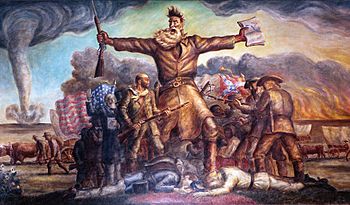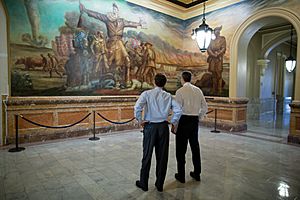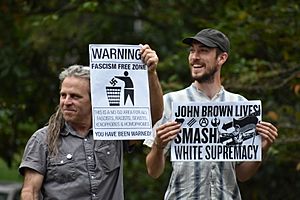Tragic Prelude facts for kids
Quick facts for kids Tragic Prelude |
|
|---|---|

Tragic Prelude, north wall. John Brown in front of and between fighting Union and Confederate soldiers.
|
|
| Artist | John Steuart Curry |
| Year | c. 1938–1940 |
| Medium | oil and egg tempera |
| Subject | History of Kansas, John Brown |
| Dimensions | 136 cm × 945 cm (136 in × 372 in); 11'4" x 31' |
| Location | Kansas State Capitol, Topeka, Kansas |
Tragic Prelude is a famous mural painted by John Steuart Curry. He was an artist from Kansas. The mural is located in the Kansas State Capitol building in Topeka, Kansas. You can find it on the second floor.
The painting shows John Brown, an important figure in American history. He holds a Bible in one hand and a rifle in the other. The rifle was sometimes called a "Beecher's Bible". John Brown stands between soldiers from the Union and the Confederacy. Some soldiers are fighting, and some are fallen. In the background, you can see a tornado and a prairie fire. These symbols represent danger and destruction. There are also covered wagons moving west.
The name "Tragic Prelude" refers to a time in Kansas history called Bleeding Kansas. This period was from 1854 to 1860. It was a time of violence and conflict. Many people saw it as a preview of the Civil War. John Brown was a key person during this time. He fought to stop Kansas from becoming a slave state. A newspaper editor named William Allen White gave this period the name "tragic prelude."
The mural is very large and wraps around a corner. This makes it hard to see all at once. Besides John Brown, it shows other important figures. These include Fray Juan de Padilla, a missionary, and Coronado, a Spanish explorer. They were the first Europeans to visit the land that became Kansas. There is also a plainsman who has just hunted a buffalo. This mural is John Steuart Curry's most famous artwork.
Contents
History of the Mural
The idea for the mural came from William Allen White. He was a newspaper editor from Kansas. He wanted John Steuart Curry to paint murals for his home state. Other newspapers agreed, and they formed the Kansas Murals Commission. This group chose Curry to create the artworks for the Capitol.
The Commission decided that Curry would be the only artist for the Kansas Capitol murals. His theme would be the history of Kansas. No state money was used for the project. Instead, William Allen White led a successful effort to raise money from the public.
Tragic Prelude was finished in 1937. Curry used a mix of egg tempera and oil paints. The mural is very big. It is about 11 feet 4 inches (3.5 meters) tall. It is also about 31 feet (9.4 meters) long.
What the Artist Said

John Steuart Curry explained his painting. He said the giant figure of John Brown is in the center. Brown holds the "word of God" and a "Beecher's Bible". Around him are the two sides fighting: those who wanted Kansas to be free and those who wanted slavery. At their feet are figures representing the many people who died in the Civil War. Curry said this part shows the "fratricidal fury" that started in Kansas. This was the "Tragic Prelude" to the big war. Behind them are pioneers traveling west in wagons. And behind everything are a tornado and a prairie fire. These are symbols of the destruction the Civil War would bring.
In 1939, Curry told a newspaper that he wanted to show John Brown as a "fanatic." He said Brown had the strong passion of an extremist for his cause. This passion led to the Civil War and its great suffering. Later, Curry wrote that he thought John Brown was like many Kansans. He said someone described a Kansan as someone who "went about wreaking good on humanity." Curry felt this idea was at the heart of his painting.
Why the Mural Was Rejected at First
The Kansas Legislature did not want to hang the mural in the Capitol at first. Curry was very upset and left Kansas. He stopped working on the rest of his Capitol art project. He did not even sign Tragic Prelude or his other completed work, Kansas Pastoral. He felt the project was not finished.
The mural was finally hung in the Capitol after Curry passed away. He had also planned other panels for the Capitol. But these were never painted beyond early sketches. Some Kansans were unhappy with his ideas for these panels. One idea blamed poor farming for the dust storms of the 1930s.
Where to Find More Information
You can see a study, or early drawing, for the mural at the Spencer Museum of Art.
The Mural in Pop Culture
The image of Tragic Prelude was used on the cover of the 1974 debut album by the rock band Kansas. The album was also called Kansas.
The image has also been used on posters and T-shirts. These were made for the yearly "Border War" between the University of Kansas and the University of Missouri.
Images for kids



